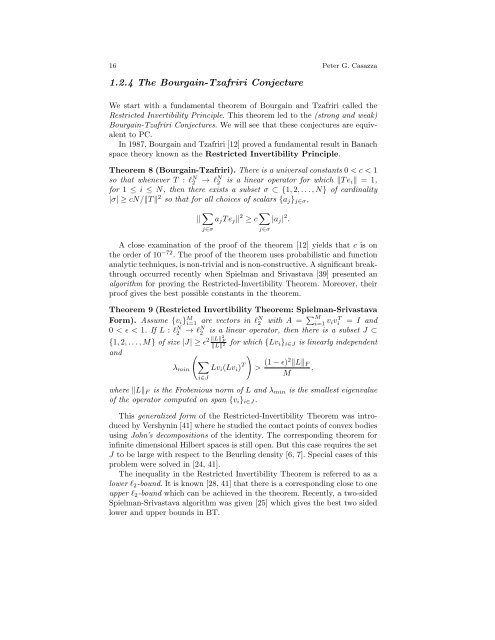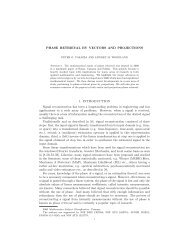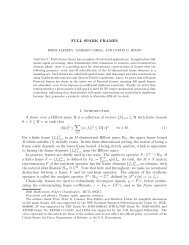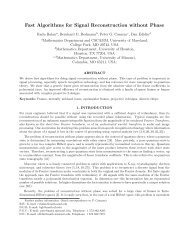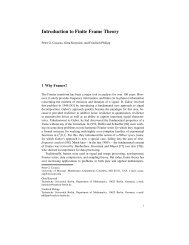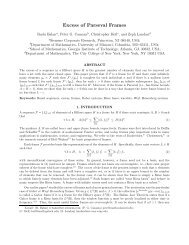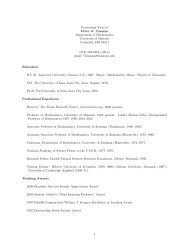The Kadison-Singer and Paulsen Problems in Finite Frame Theory
The Kadison-Singer and Paulsen Problems in Finite Frame Theory
The Kadison-Singer and Paulsen Problems in Finite Frame Theory
You also want an ePaper? Increase the reach of your titles
YUMPU automatically turns print PDFs into web optimized ePapers that Google loves.
16 Peter G. Casazza1.2.4 <strong>The</strong> Bourga<strong>in</strong>-Tzafriri ConjectureWe start with a fundamental theorem of Bourga<strong>in</strong> <strong>and</strong> Tzafriri called theRestricted Invertibility Pr<strong>in</strong>ciple. This theorem led to the (strong <strong>and</strong> weak)Bourga<strong>in</strong>-Tzafriri Conjectures. We will see that these conjectures are equivalentto PC.In 1987, Bourga<strong>in</strong> <strong>and</strong> Tzafriri [12] proved a fundamental result <strong>in</strong> Banachspace theory known as the Restricted Invertibility Pr<strong>in</strong>ciple.<strong>The</strong>orem 8 (Bourga<strong>in</strong>-Tzafriri). <strong>The</strong>re is a universal constants 0 < c < 1so that whenever T : l N 2 → l N 2 is a l<strong>in</strong>ear operator for which ‖T e i ‖ = 1,for 1 ≤ i ≤ N, then there exists a subset σ ⊂ {1, 2, . . . , N} of card<strong>in</strong>ality|σ| ≥ cN/‖T ‖ 2 so that for all choices of scalars {a j } j∈σ ,‖ ∑ a j T e j ‖ 2 ≥ c ∑j∈σj∈σ|a j | 2 .A close exam<strong>in</strong>ation of the proof of the theorem [12] yields that c is onthe order of 10 −72 . <strong>The</strong> proof of the theorem uses probabilistic <strong>and</strong> functionanalytic techniques, is non-trivial <strong>and</strong> is non-constructive. A significant breakthroughoccurred recently when Spielman <strong>and</strong> Srivastava [39] presented analgorithm for prov<strong>in</strong>g the Restricted-Invertibility <strong>The</strong>orem. Moreover, theirproof gives the best possible constants <strong>in</strong> the theorem.<strong>The</strong>orem 9 (Restricted Invertibility <strong>The</strong>orem: Spielman-SrivastavaForm). Assume {v i } M i=1 are vectors <strong>in</strong> lN 2 with A = ∑ Mi=1 v ivi T = I <strong>and</strong>0 < ɛ < 1. If L : l N 2 → l N 2 is a l<strong>in</strong>ear operator, then there is a subset J ⊂{1, 2, . . . , M} of size |J| ≥ ɛ 2 ‖L‖ 2 F‖L‖ 2<strong>and</strong>( )∑λ m<strong>in</strong> Lv i (Lv i ) Ti∈Jfor which {Lv i } i∈J is l<strong>in</strong>early <strong>in</strong>dependent> (1 − ɛ)2 ‖L‖ FMwhere ‖L‖ F is the Frobenious norm of L <strong>and</strong> λ m<strong>in</strong> is the smallest eigenvalueof the operator computed on span {v i } i∈J .This generalized form of the Restricted-Invertibility <strong>The</strong>orem was <strong>in</strong>troducedby Vershyn<strong>in</strong> [41] where he studied the contact po<strong>in</strong>ts of convex bodiesus<strong>in</strong>g John’s decompositions of the identity. <strong>The</strong> correspond<strong>in</strong>g theorem for<strong>in</strong>f<strong>in</strong>ite dimensional Hilbert spaces is still open. But this case requires the setJ to be large with respect to the Beurl<strong>in</strong>g density [6, 7]. Special cases of thisproblem were solved <strong>in</strong> [24, 41].<strong>The</strong> <strong>in</strong>equality <strong>in</strong> the Restricted Invertibility <strong>The</strong>orem is referred to as alower l 2 -bound. It is known [28, 41] that there is a correspond<strong>in</strong>g close to oneupper l 2 -bound which can be achieved <strong>in</strong> the theorem. Recently, a two-sidedSpielman-Srivastava algorithm was given [25] which gives the best two sidedlower <strong>and</strong> upper bounds <strong>in</strong> BT.,


